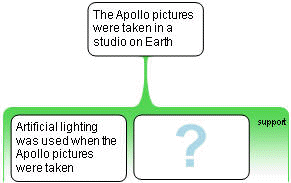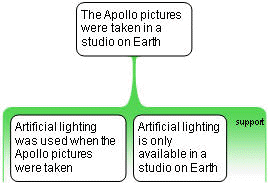
 |
|
|
|
|
| 2.5 Hidden Premises | |
Usually when people provide reasons or objections they don't explicitly state all the premises. In other words, people typically "hide" one or more co-premises.
| Artificial lighting was used when the Apollo pictures were taken, and therefore the pictures were taken in a studio on Earth. [Based on 5.1] In this simple argument, only one premise is provided. Any others are currently "hidden." |
 What is the hidden co-premise? What claim "works together" with the stated premise so that both together can provide evidence? |
 Here is one suggestion as to what the hidden premise might be. |
| Discussion |
If, as the Golden Rule says, every reason or objection has at least two co-premises, why do people usually hide some of them? Often, co-premises are obvious or uncontroversial and don't really need to be explicitly stated. However there are many other explanations. People tend to be one or more of the following...
When people hide co-premises, they are leaving it to us, as listeners or readers, to fill in the gaps. This often involves a lot of effort and skill.
Since argument mapping is all about making the structure of reasoning explicit, if we are doing our job in a completely thorough way, we will identify all co-premises, which means identifying all hidden premises. This is one of the biggest challenges in argument mapping.
Logicians also use various other terms for hidden premises. Some you might encounter include:
Logicians use the term enthymeme for an argument with a hidden premise. Most arguments encountered in everyday contexts are enthymematic.
| New Concepts |
A hidden premise is a co-premise which is not actually stated when an argument is presented.
| Glossary | Contents | |
|
Copyright © Critical Thinking Skills BV - |
|